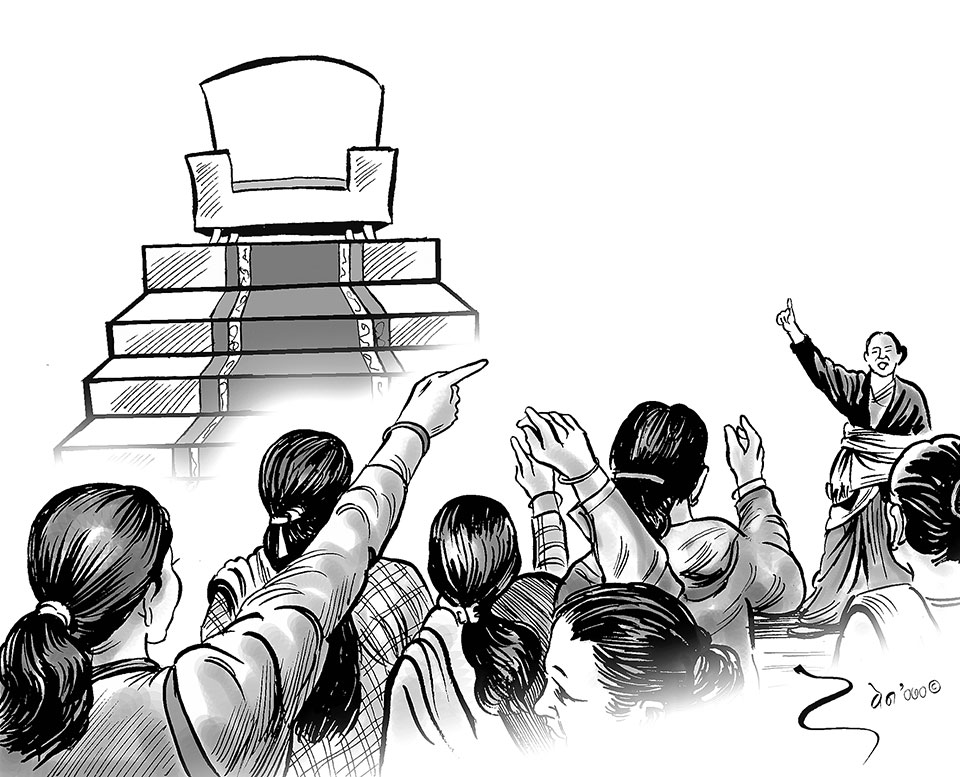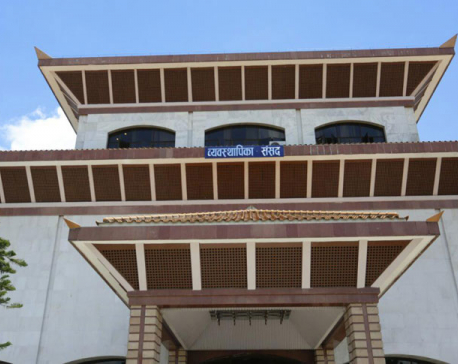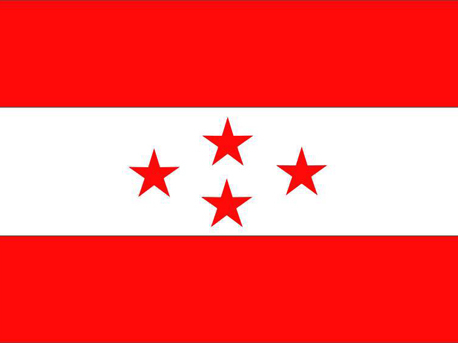
OR
Century-long history of Nepali women's struggle leads to increasing participation in policy-making
Published On: March 8, 2023 05:00 PM NPT By: Arun Bam

KATHMANDU, March 8: While the world is celebrating the 113th International Women's Day, Nepal is also celebrating Women's Day on Wednesday, stressing the guarantee of women’s rights. In addition, over a century has passed since women started coming forward with an organized voice.
For the first time in Nepal, religious guru and poet Yogmaya Neupane started to raise her voice regarding women's rights by forming a ‘Women’s Committee’ in 1918. Because of it, historians claim that the then Rana rulers were compelled to put an end to the sati and slavery traditions. Thus, it seems that it has been 105 years since Yogmaya Neupane started an organized women's movement in the country.
Neupane had started raising her voice on the inconsistencies of religion and culture through her religious writings even before forming the women's group. After the formation of the Women's Committee, she started an organized rebellion against social violence and discrimination against women. It is said that this affected the practice of the Sati tradition. In 1921, the then prime minister Chandra Shumsher Junga Bahadur Rana put an end to the practice of the Sati tradition after a group led by Neupane started raising their voice against the ill tradition.
Then Neupane's group started a campaign raising their voice against the slavery system. As a result, the slavery system was abolished in 1925. During her lifetime, Neupane continued to raise her voice for the prohibition of child marriage, promotion of rights allowing widows to remarry and women to read the Vedas, and for women to be given equal opportunities as men, and against the hierarchical caste system.
Various historians have mentioned that as Neupane's voice became stronger, the then Rana rulers began to oppress her. After 1936, she started raising her voice demanding an end to injustice, superstitions and corrupt practices prevalent in the Nepali society. For which she announced a mass self-immolation campaign.
During this time, on July 5, 1941, on the day of Harishayani Ekadashi, she committed self-immolation on the bank of the Arun River. Historians have reported that a total of 68 people committed self-immolation along with her.
In this way, the voice of Nepali women demanding rights and social transformation has been getting louder since then in an organized way. Then in 1947, an organization named Adarsha Mahila Samaj was established to make women politically and socially conscious.
In 1948, the Nepal Women’s Assosciation was established under the chairpersonship of Mangala Devi Singh with the aim of making women aware of child marriage, polygamy, mismatched marriages, etc, against injustice, exploitation and inequality against women. This Women's Association created awareness by imparting education to women and women's suffrage as a major issue.
Women's movement for right to vote
After the establishment of democracy in the country in 1951, the first municipal election was held in 1952. In that election, which was conducted by the then Rana Prime Minister Mohan Shumsher, the government was against the idea of providing women the voting right.
This led to the Nepal Women's Association starting a movement against the government. Sahana Pradhan, Sadhana Pradhan Adhikari, Kanak Lata Shrestha, Sneh Lata Shrestha and other women protested against the government on behalf of the association under the leadership of chairperson Singh.
The Women's Association team that accompanied the demonstration met Prime Minister Mohan Shumsher and handed him a memorandum. Initially, the government tried to suppress the movement.
However, as the agitating women weren’t ready to step back, they were eventually given the right to vote. According to which Sadhana Pradhan (Adhikari) was elected as a municipal member in the municipal election. Pradhan became the first elected woman representative of Nepal.
Dwarika Devi Thakurani - the first woman MP
It took eight years to hold the first parliamentary elections after the establishment of democracy in 1951. Only one woman member was elected in the 1959 elections to the House of Representatives. Dwarika Devi Thakurani, a candidate from the Nepali Congress, was elected from Constituency No. 66 (Dadeldhura-Baitadi) in the election. Election Commission data shows that she received 3,903 votes. There were seven women candidates in that election.
Under the leadership of Bisheshwar Prasad Koirala after the formation of the first democratically-elected government, Thakurani became the first deputy minister for Health and Self governance on May 20, 1959.
When the late King Mahendra dissolved the elected government on December 21, 1960, Shailaja Acharya who was just 16 years old back then, hit the streets carrying a black flag.
Acharya was jailed for three years just for hitting the street. Then, during the Panchayat period, along with political changes, Nepali women struggled more to end social discrimination and to achieve women's political rights.
Provision for five percent women candidates in HoR election
Due to the people’s struggle in 1989, Article 114 of the Constitution of the Kingdom of Nepal, 1990, made a provision which stipulated that the political parties must nominate at least five percent women candidates in the House of Representatives elections.
According to this provision, eight, seven and 12 women MPs were elected in the elections to the House of Representatives in 1991, 1994 and 1999, respectively. According to this constitution, the representation of women in the national assembly and local bodies was made mandatory. There was a constitutional provision that there should be at least three women members in the National Assembly.
Mandatory 33 percent women’s representation in parliament
After the Second People's Movement in 2006, the voice of women's participation in policy-making became even stronger. As a result, at least 33 percent women participation in parliament became mandatory.
Second Constituent Assembly
In the first Constituent Assembly, 32.78 percent of women were elected as members of the Constituent Assembly, while in the second Constituent Assembly, the representation of women members was lowered to 29.28 percent.
After the Constitution of Nepal 2015 was promulgated by the second Constituent Assembly, legal frameworks were put in place for women's participation in the leadership. According to this provision, at least 33 percent of women participation in the federal parliament and provincial assemblies has been constitutionally guaranteed. And as a result, if 33 percent women participation is not ensured through the first-past-the-post election or direct election, parties are compelled to elect women through the proportional representation to meet the constitutional provision.
Accordingly, 112 women were elected to the Federal Parliament out of a total of 334 lawmakers in the 2017 House of Representatives and National Assembly which is 33.53 percent. In the last elections, 33.10 percent of women were elected to the House of Representatives, while 36.36 percent of women were elected to the provincial assemblies.
Similarly, the constitution has also promoted the issue of gender inclusion in government positions. Accordingly, women rose to crucial state positions like President and Speaker. Similarly, the participation of women has been ensured at the local level as well. Recently, about 41 percent of women were elected in the last local elections.
You May Like This

'Unequal budget distribution' riles lawmakers
KATHMANDU, July 6: Some lawmakers, taking part in the deliberations on various topics incorporated in the Appropriation Bill-2017 in the Legislature-Parliament... Read More...

NC lawmakers object to protest against amendment bill
KATHMANDU, Dec 1: Nepali Congress (NC) lawmakers have expressed a stern objection to the protest against the constitution amendment bill. Read More...

Protesting UDMF lawmakers boycott House meeting
KATHMANDU, June 30: The United Democratic Madhesi Front which is up in arms against some provisions of the constitution boycotted... Read More...







Just In
- Govt appoints 77 Liaison Officers for mountain climbing management for spring season
- EC decides to permit public vehicles to operate freely on day of by-election
- Fugitive arrested after 26 years
- Indian Potash Ltd secures contract to bring 30,000 tons of urea within 107 days
- CAN adds four players to squad for T20 series against West Indies 'A'
- ‘Precast' technology introduced in the construction of bridges along Muglin-Pokhara road
- Leopard attack injures young man in Kanchanpur
- SC rejects writ petition filed against Home Minister Lamichhane












Leave A Comment